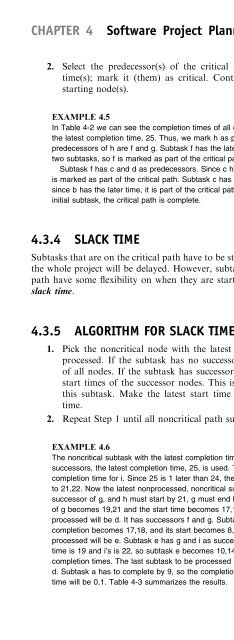Create successful ePaper yourself
Turn your PDF publications into a flip-book with our unique Google optimized e-Paper software.
CHAPTER 4 Software Project Planning 53<br />
2. Select the predecessor(s) of the critical node(s) with latest completion<br />
time(s); mark it (them) as critical. Continue Step 2 until reaching the<br />
starting node(s).<br />
EXAMPLE 4.5<br />
In Table 4-2 we can see the completion times of all of the subtasks. Subtask h has<br />
the latest completion time, 25. Thus, we mark h as part of the critical path. The<br />
predecessors of h are f and g. Subtask f has the latest completion time of those<br />
two subtasks, so f is marked as part of the critical path.<br />
Subtask f has c and d as predecessors. Since c has the later completion time, c<br />
is marked as part of the critical path. Subtask c has a and b as predecessors, and<br />
since b has the later time, it is part of the critical path. Since we are now at an<br />
initial subtask, the critical path is complete.<br />
4.3.4 SLACK TIME<br />
Subtasks that are on the critical path have to be started as early as possible or else<br />
the whole project will be delayed. However, subtasks that are not on the critical<br />
path have some flexibility on when they are started. This flexibility is called the<br />
slack time.<br />
4.3.5 ALGORITHMFOR SLACK TIME<br />
1. Pick the noncritical node with the latest ending time that has not been<br />
processed. If the subtask has no successors, pick the latest ending time<br />
of all nodes. If the subtask has successors, pick the earliest of the latest<br />
start times of the successor nodes. This is the latest completion time for<br />
this subtask. Make the latest start time for this subtask to reflect this<br />
time.<br />
2. Repeat Step 1 until all noncritical path subtasks have been processed.<br />
EXAMPLE 4.6<br />
The noncritical subtask with the latest completion time is subtask i. Since it has no<br />
successors, the latest completion time, 25, is used. This is added as the latest<br />
completion time for i. Since 25 is 1 later than 24, the start time is changed from 21<br />
to 21,22. Now the latest nonprocessed, noncritical subtask is g. Since h is the only<br />
successor of g, and h must start by 21, g must end by 21. So the completion time<br />
of g becomes 19,21 and the start time becomes 17,19. The next subtask to be<br />
processed will be d. It has successors f and g. Subtask f has to start by 18, so d’s<br />
completion becomes 17,18, and its start becomes 8,9. The next subtask to be<br />
processed will be e. Subtask e has g and i as successors. Subtask g’s latest start<br />
time is 19 and i’s is 22, so subtask e becomes 10,14 for start times and 15,19 for<br />
completion times. The last subtask to be processed is a. It has successors c and<br />
d. Subtask a has to complete by 9, so the completion time will be 8,9, and its start<br />
time will be 0,1. Table 4-3 summarizes the results.









